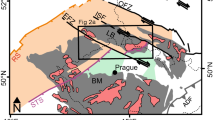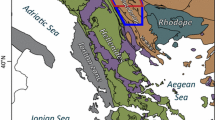40
Ar/39Ar–mica and 207Pb/206Pb–zircon dates are presented and combined with existing P–T data and the sedimentary record. These data indicate that the RCC was faulted into three segments which underwent different exhumation histories during the Late Carboniferous/Early Permian. The eastern segment shows 40Ar/39Ar–biotite data of336 ±4 and 323±3 Ma. Furthermore, it is intruded by the Thuringian Hauptgranite dated at 337±4 Ma by the 207Pb/206Pb single zircon method. At approximately 300 Ma rocks of the eastern segment were finally exposed and, subsequently, subsided as part of the Oberhof pull-apart basin, filled by Late Carboniferous/Early Permian molasse sediments and volcanic rocks (296–285 Ma; Goll 1996). A similar Late Carboniferous evolution is inferred for the western segment, since it is also overlain by Upper Carboniferous volcanic rocks. In contrast to the eastern and western segments, distinctly younger intrusion and cooling ages were recorded for the central segment of the RCC (40Ar/39Ar muscovite: 311±3 Ma; 40Ar/39Ar biotite: 293–288±3 Ma) that was intruded by the Trusetal Granite, the Ruhla Granite and Brotterode Diorite (207Pb/206Pb single zircon: 298±2, 295±3, 289±4 Ma, respectively). These young data are unique in the MGCR and testify that plutonic activity and cooling of basement rocks took place simultaneously with basin formation and volcanism in the eastern and western segments. Overlying Upper Permian (Zechstein) and Triassic sediments indicate final exposure of the central segment by approximately 260 Ma, as a part of the Ruhla-Schleusingen Horst. Combination of these results with P–T data from the contact aureole of the Trusetal granite indicate that the central segment was unroofed by at least 8.5 km during the Late Carboniferous. The Late Carboniferous/Early Permian horst-basin formation, documented in the RCC, is due to dextral transtensional movements along the NW-trending Franconian fault system. It may have been enhanced by mantle upwelling widespread in Central Europe during the Early Permian that also caused intensive magmatism in the Thuringian Forest region.
Similar content being viewed by others
Author information
Authors and Affiliations
Additional information
Received: 2 February 1999 / Accepted: 15 November 1999
Rights and permissions
About this article
Cite this article
Zeh, A., Cosca, M., Brätz, H. et al. Simultaneous horst-basin formation and magmatism during Late Variscan transtension: evidence from 40Ar/39Ar and 207Pb/206Pb geochronology in the Ruhla Crystalline Complex. Int Journ Earth Sciences 89, 52–71 (2000). https://doi.org/10.1007/s005310050317
Issue Date:
DOI: https://doi.org/10.1007/s005310050317




